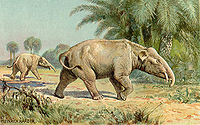| Palaeomastodon Temporal range: Oligocene, 33.9–23.03 Ma PreꞒ Ꞓ O S D C P T J K Pg N | |
|---|---|

| |
| P. beadnelli skull | |
| Scientific classification | |
| Domain: | Eukaryota |
| Kingdom: | Animalia |
| Phylum: | Chordata |
| Class: | Mammalia |
| Order: | Proboscidea |
| Family: | †Palaeomastodontidae |
| Genus: | †Palaeomastodon Andrews, 1901 |
| Type species | |
| †Palaeomastodon beadnelli Andrews, 1901 | |
| Species | |
| |
Palaeomastodon ("ancient mastodon") is an extinct genus within the elephant order Proboscidea. Its fossils have been extracted from Oligocene strata conventionally dated to 33.9-23.03 million years old. Usually considered an ancestor or near-ancestor of elephants or mastodons as a member of Elephantiformes it lived in marshes and fluvial-deltaic environments of what is now Egypt, Ethiopia, Libya, and Saudi Arabia.
 Artistic representation by Heinrich Harder
Artistic representation by Heinrich Harder Life reconstruction of Palaeomastodon beadnelli
Life reconstruction of Palaeomastodon beadnelli Artistic representation
Artistic representation
Few postcranial remains are known. However, based on the reported 875 mm length of one P. beadnelli femur, a 2016 study estimated an adult shoulder height of about 2.2 metres (7.2 ft) with a mass over 2.5 tonnes (2.8 short tons).
Palaeomastodonts possessed both maxillary and mandibular tusks. The mandibular tusks projected anteriorly and were generally flat and scoop-like. They were probably used to scrape the bark off trees and uproot various plants. By contrast, the sharp maxillary tusks primarily functioned as defensive weapons. Unlike later proboscideans belonging to Elephantimorpha, the teeth erupted vertically rather than horizontally, as shared with other "paleomastodonts" like Phiomia.
The form, size, and capabilities of palaeomastodont nasal structures have long been debated. Though often depicted with a relatively small, prehensile proboscis, Osborn 1909 argued that wear patterns on the lower tusks better favored the presence of a large, retractile upper lip.
References
- The genus Palaeomastodon Archived 2008-10-17 at the Wayback Machine
- Larramendi, A. (2016). "Shoulder height, body mass and shape of proboscideans" (PDF). Acta Palaeontologica Polonica. 61. doi:10.4202/app.00136.2014.
- Osborn, H. F. (1909). "The Feeding Habits of Mœritherium and Palæomastodon". Nature. 81 (2074): 139–140. Bibcode:1909Natur..81..139O. doi:10.1038/081139a0.
- Sanders, William J. (2018-02-17). "Horizontal tooth displacement and premolar occurrence in elephants and other elephantiform proboscideans". Historical Biology. 30 (1–2): 137–156. Bibcode:2018HBio...30..137S. doi:10.1080/08912963.2017.1297436. ISSN 0891-2963.
| Genera of the order Proboscidea | ||||||||||||||||||||||||||||||
|---|---|---|---|---|---|---|---|---|---|---|---|---|---|---|---|---|---|---|---|---|---|---|---|---|---|---|---|---|---|---|
| ||||||||||||||||||||||||||||||
| 
 | |||||||||||||||||||||||||||||
| Taxon identifiers | |
|---|---|
| Palaeomastodon | |
This article about a prehistoric proboscidean is a stub. You can help Misplaced Pages by expanding it. |
